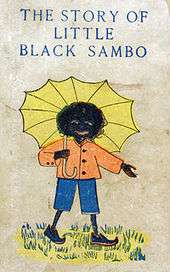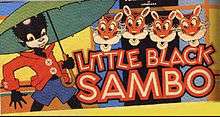The Story of Little Black Sambo
 1st edition | |
| Author | Helen Bannerman |
|---|---|
| Illustrator | Helen Bannerman |
| Country | United Kingdom |
| Language | English |
| Genre | Children's literature |
| Publisher | Grant Richards, London |
Publication date | 1899 |
| Media type | |
The Story of Little Black Sambo is a children's book written and illustrated by Scottish author Helen Bannerman, and first published by Grant Richards in October 1899 as one in a series of small-format books called The Dumpy Books for Children. The story was a children's favorite for more than half a century but would become a victim of allegations of racism in the mid-20th century. Critics of the time observed that Bannerman presents one of the first black heroes in children's literature and regarded the book as positively portraying black characters in both the text and pictures, especially in comparison to the more negative books of that era that depicted blacks as simple and uncivilized.[1] Both text and illustrations have undergone considerable revision since.
Plot
Sambo is a South Indian boy who lives with his father and mother, named Black Jumbo and Black Mumbo, respectively. While out walking, Sambo encounters four hungry tigers, and surrenders his colourful new clothes, shoes, and umbrella so they will not eat him. The tigers are vain and each thinks he is better dressed than the others. They chase each other around a tree until they are reduced to a pool of ghee. Sambo then recovers his clothes and collects the ghee, which his mother uses to make pancakes.[2]
Controversy
The book's original illustrations were done by the author and simple in style, typical of most children's books, and depicted Sambo as a Southern Indian or Tamil child. The book has thematic similarities to Rudyard Kipling's The Jungle Book, published in 1894, which had far more sophisticated illustrations. However, Little Black Sambo's success led to many counterfeit, inexpensive, widely available versions that incorporated popular stereotypes of "black" peoples. For example, in 1908 John R. Neill, best known for his illustration of the Oz books by L. Frank Baum, illustrated an edition of Bannerman's story.[3] In 1932 Langston Hughes criticised Little Black Sambo as a typical "pickaninny" storybook which was hurtful to black children, and gradually the book disappeared from lists of recommended stories for children.[4]

In 1942, Saalfield Publishing Company released a version of Little Black Sambo illustrated by Ethel Hays.[5] During the mid-20th century, however, some American editions of the story, including a 1950 audio version on Peter Pan Records, changed the title to the racially neutral Little Brave Sambo.
In 1957, an illustrated children's book, Come To Eat (בואו לאכול), written by Avigdor Hameiri and illustrated by Mariam Bartov, was published in Hebrew in Israel. It tells the story about Mother Mambo and Father Sambo trying to get their little boy Bambo to eat his supper. Only after Bambo watches a series of animals only too happy to eat his food does he learn his lesson and come home to eat his supper. The story contains no racist overtones and reads as any number of stories of mildly rambunctious children.[6]
The book is beloved in Japan and is not considered controversial there, but it was subject to copyright infringement. Little Black Sambo (ちびくろサンボ Chibikuro Sanbo) was first published in Japan by Iwanami Shoten Publishing in 1953. The book was an unlicensed version of the original, and it contained drawings by Frank Dobias that had appeared in a US edition published by Macmillan Publishers in 1927. Sambo was illustrated as an African boy rather than as an Indian boy. Although it did not contain Bannerman's original illustrations, this book was long mistaken for the original version in Japan. It sold over 1,000,000 copies before it was pulled off the shelves in 1988 after copyright issues were raised.[7] When the copyright expired, Kodansha and Shogakukan, the two largest publishers in Japan, published official editions. These are still in print.
As of August 2011, an equally uncontroversial "side story" for Little Black Sambo, called Ufu and Mufu, is being sold and merchandised in Japan.
Modern versions
In 1996, noted illustrator Fred Marcellino observed that the story itself contained no racist overtones and produced a re-illustrated version, The Story of Little Babaji, which changes the characters' names but otherwise leaves the text unmodified.[8]
Julius Lester, in his Sam and the Tigers, also published in 1996, recast "Sam" as a hero of the mythical Sam-sam-sa-mara, where all the characters were named "Sam".
A modern printing with the original title, in 2003, substituted more racially sensitive illustrations by Christopher Bing, in which, for example, Sambo is no longer so inky black. It was chosen for the Kirkus 2003 Editor's Choice list. Some critics were still unsatisfied. Dr Alvin F. Poussaint said of the 2003 publication: "I don't see how I can get past the title and what it means. It would be like ... trying to do 'Little Black Darky' and saying, 'As long as I fix up the character so he doesn't look like a darky on the plantation, it's OK.'"
In 1997, a Japanese retelling of the story, Chibikuro Sampo ("sampo" means "taking a walk" in Japanese, "Chibi" means "little" and "kuro" means black), replaced the protagonist with a black Labrador puppy that goes for a stroll in the jungle. It was published by Mori Marimo from Kitaooji Shobo Publishing in Kyoto. This publication was denounced by a 3-person organization calling itself "The Association To Stop Racism Against Blacks", which consisted of a woman (the president), her husband (the vice president), and their 10-year-old son (the treasurer). Kitaooji Shobo refused to stop the publication.[7]
Bannerman's original was first published with a translation of Masahisa Nadamoto by Komichi Shobo Publishing, Tokyo, in 1999.
In 2004, a Little Golden Book version was published, The Boy and the Tigers, with new names and illustrations by Valeria Petrone. The boy is called Little Rajani.
The Iwanami version, with its controversial Dobias illustrations and without the proper copyright, was re-released in April 2005 in Japan by a Tokyo-based publisher Zuiunsya, because Iwanami's copyright expired after fifty years of its first appearance.
Sam from Little Black Sambo appears in Jack of Fables Volume 1: The (Nearly) Great Escape. He is a prisoner of Golden Burroughs, a prison for Fables.
The band R.E.M. referenced the story of Little Black Sambo in the 1986 song "Begin the Begin": "On Zenith, on the TV, tiger run around the tree. Follow the leader, run and turn into butter."
It was retold as "Little Kim" in a storybook and cassette as part of the Once Upon a Time Fairy Tale Series where Sambo is called "Kim", his father Jumbo is "Tim" and his mother Mumbo is "Sim".
Adaptations

A board game was produced in 1924 and re-issued in 1945, with different artwork. Essentially the game followed the storyline, starting and ending at home.
In the 1930s, Wyandotte Toys used a pickaninny caricature "Sambo" image for a dart-gun target.[9]
An animated version of the story was produced in 1935 as part of Ub Iwerks' ComiColor series. Little Black Sambo appeared again in Bugs Bunny's cartoon All this and Rabbit Stew.
Columbia Records issued a 1946 version on two 78 RPM records with narration by Don Lyon.[10] It was issued in a folder with artwork showing Sambo to be quite black indeed, though the narrative preserves the locale as India.[11]
In 1961, HMV Junior Record Club issued a dramatized version - words by David Croft, music by Cyril Ornadel - with Susan Hampshire in the title role and narrated by Ray Ellington.[12]
Restaurant
An independent restaurant founded in 1957 in Lincoln City, Oregon, is named Lil' Sambo's after the fictional character.[13]
Coincidentally, a popular U.S. restaurant chain of the 1950s, 60s and 1970s, Sambo's, borrowed characters from the book (including Sambo and the tigers) for promotional purposes, although the Sambo name was originally a combination of the founders' names and nicknames: Sam (Sam Battistone) and Bo (Newell Bohnett).[14] Nonetheless, the controversy about the book led to accusations of racism that contributed to the 1,117-restaurant[15] chain's demise in the early 1980s.[14] Images inspired by the book (now considered by some racially insensitive) were common interior decorations in the restaurants.[16] Though portions of the original chain were renamed No Place Like Sam's to try to forestall closure,[15] all but the original restaurants in Santa Barbara, California, had closed by 1983. The original location still exists in Santa Barbara under the name Sambo's.[17]
See also
- List of banned books
- Zambo (or in Southern Spanish Sambo/sambo), a term used in the Spanish colonial caste system to denote a person with both African and Amerindian ancestry.
- Ethnic issues in Japan
- Murzynek Bambo - Little black Bambo by Polish writer Julian Tuwim
- Jynx
References
- ↑ "Helen Bannerman on the Train to Kodaikanal". Archived from the original on May 15, 2007. Retrieved April 11, 2007.
- ↑ The Story of Little Black Sambo .sterlingtimes.co.uk
- ↑ Bernstein, Robin (2011). Racial Innocence: Performing American Childhood from Slavery to Civil Rights. New York: New York University Press. pp. 66–67. Retrieved January 4, 2012.
- ↑ David Pilgrim, "The Picaninny Caricature," Jim Crow Museum of Racist Memorabilia.
- ↑ "Mimi Kaplan collection, 1900 - 1920 - Rare Book & Manuscript Library, University of Illinois at Urbana-Champaign".
- ↑ Hameiri (הםאירי), Avigdor (אביגדור) (1957). Come To Eat (בואו לאכול). Israel: Sinai.
- 1 2 Kazuo Mori (2005). "A Comparison of Amusingness for Japanese Children and Senior Citizens of The Story of Little Black Sambo" (PDF). Social Behavior and Personality. Society for Personality Research/Shinshu University. 33 (5): 455–466.
- ↑ Golus, Carrie. "Sambo’s subtext", The University of Chicago Magazine, September-October 2010
- ↑ "Tin Toys #1".
- ↑ "Little Black Sambo, by Don Lyon (1946)".
- ↑ "Don Lyon - Little Black Sambo".
- ↑ "Various Artists - Black Sambo, Black Sambo".
- ↑ "Lil Sambos Restaurant in Lincoln city". Retrieved March 7, 2016.
- 1 2 "Massachusetts asks ban on 'Sambo's' name". The Miami News. September 27, 1978. p. 4a.
Prosecutors say unless the name is banned, "Racial tensions will increase."
- 1 2 "Sambo's to Alter Northeast Names". The New York Times. March 11, 1981.
- ↑ "Sambo's restaurants file for voluntary bankruptcy". The Deseret News. November 27, 1981. p. 6e.
- ↑ "On This Date in Santa Barbara: Sambo's Opens". June 17, 2014. Retrieved June 25, 2014.
Further reading
- Barbara Bader (1996). "Sambo, Babaji, and Sam", The Horn Book Magazine. September–October 1996, vol. 72, no. 5, p. 536.
- Phyllis Settecase Barton (1999). Pictus Orbis Sambo: A Publishing History, Checklist and Price Guide for The Story of Little Black Sambo (1899–1999) Centennial Collector's Guide. Pictus Orbis Press, Sun City, CA.
- Dashini Jeyathuray (2012). "The complicated racial politics of Little Black Sambo", South Asian American Digital Archive. April 5, 2012:
- Kazuo Mori (2005). "A Comparison of Amusingness for Japanese Children and Senior Citizens of The Story of Little Black Sambo in the Traditional Version and Nonracist Version." Social Behavior and Personality, Vol. 33, pp. 455–466.
External links
 Media related to Little Black Sambo at Wikimedia Commons
Media related to Little Black Sambo at Wikimedia Commons- The Story of Little Black Sambo (1923 authorized American edition) at Internet Archive.
- The Story of Little Black Sambo (illus. John R. Neill) at Internet Archive.